|
FAQs About Soft/Shell Rot, Conditions In
Turtles 16
Related Articles:
Shell Rot in Turtles,
Treating Common Illnesses of
the Red Ear Slider (& other Emydid Turtles) by Darrel
Barton,
The
Care and Keeping of the Red Eared Slider,
Trachemys scripta
elegans
by Darrel Barton,
Red Ear Sliders,
Turtles,
Amphibians, Red Eared Slider Care,
Related FAQs:
Shell Rot 2,
Shell Rot 3,
Shell Rot 4,
Shell Conditions 5
Shell Conditions 6,
Shell Conditions 7,
Shell Conditions 8,
Shell Conditions 9,
Shell Conditions 11,
Shell Conditions 12,
Shell Conditions 13,
Shell
Conditions 14,
Shell Conditions 15,
Shell Conditions 17,
&
Turtles,
Turtles 2,
Turtle Identification,
Turtle Behavior,
Turtle Compatibility,
Turtle Selection,
Turtle Systems,
Turtle Feeding,
Turtle Disease,
Turtle Disease 2,
Turtle Disease 3,
Turtle Reproduction,
Amphibians,
Other Reptiles,
|
|
Young male RES scute shed before it was ready
1/3/14
Hello,
<Hiya - Darrel here>
I have an Red Eared Slider that has a scute that came off before it was
ready, I was doing his daily feeding and he ate used the rest room and moved
around just fine, reading elsewhere and on your site I have come to the
conclusion of dry docking him
<Right!! Thanks for reading first & asking second!>
I only used triple antibacterial as I did not have hydrogen peroxide and
betadine as this happened later in the night,
<Good thinking>
When the scute came off underneath it was a filmy white, sort of gummy, but
the shell underneath wasn't soft but not hard hard like normal, the scute
wasn't super thin but bendable and fairly see through, I can see his shell
pattern on the part that is exposed now
<What you're seeing is the bone underneath the scute>
He bled a little, I think just in the part that is exposed, a herp vet is
possible but I really momentarily have very strict finances unless he is in
danger from this
<Not yet, he's not in danger>
He has been dry docked with only a little water not above his shell for a
little while.
<yes>
How long should he be kept dry docked? I've seen everything from a few days
to a
few weeks, I want him to be able to eat and get the lighting he needs, but
not sure how to accomplish it as I'm not sure how to hold the lighting,
right now he is in his feeding tub just to keep him dry, its about 80
degrees in the room he is in, does he need warmer and how would I do that?
<The description for Dry-Docking tells you to move his UV lamp if you can,
but it's not critical. What is important is that you keep him DRY
until this area heals>
His lamps get really hot and I worry about them on anything other than his
wire mesh tank top and his tub doesn't have high enough sides to put it on
there, he would be too close to them.
<Then don't worry about it. I share your concern that he can get
too hot and we don't want that.>
I'm very worried as I don't want anything to happen to him, how would I
treat this? I'm including a picture, the picture makes it look a little
redder than it is, it did bleed but I don't think too much. It's in the top.
Half where the scute is gone
<For whatever reason, the scute has died and fallen off. It won't grow
back, but what will happen instead is this area will grow over with scar
tissue. It really isn't that big a deal as long as you treat it like
any other wound, which you seem to be doing just fine. Keep him warm
and DRY except for a daily, shallow bath so he can drink, poop and eat.
Even the scute can get wet. Getting it wet won't hurt it - just
KEEPING it wet would hurt it.>
<Give him 6 weeks in dry dock until the wound looks healed and feels hard,
then he's good to go back.>
<Because he's had this damage, you should be a bit extra careful to keep his
water clean and sanitary. This are will tend to be a BIT more
sensitive to infection. I said just a BIT -- so don't get paranoid…
just be sure to keep his water as clean as we know we should anyway>
<As long as the area heals over, no need for a trip to the vet>
|
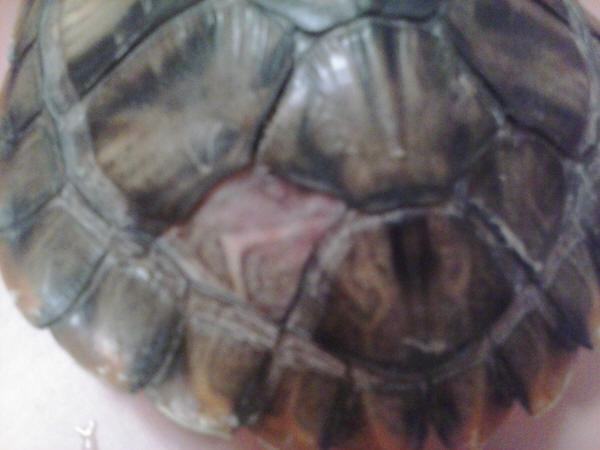 |
|
Hi I want to know if this is shell rot? – 09/10/13
Please help I came home last night and noticed its white where a scute
should be Idk if it's a crack or rot, she's acting normal and when I touch
the white part it's hard
<The last is a good sign... need to know re water quality (set up,
maintenance) and nutrition. That the area is not putrescent (by your
omission) points to damage, calcification instead of rot per se... Let's
have you read re starting here:
http://www.wetwebmedia.com/TurtShlCF16.htm
and the linked files above. Bob Fenner>
|
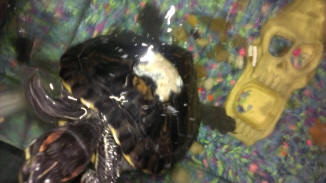
|
Re: Hi I want to know if this is shell rot?
9/11/13
when I picked her up she had a couple of loose scutes and I uncovered
more white shell, is this fixable? The last picture is how I have the
tank right now normally on top I have the lamp. She is about 5 years old
and she lives with another red ear he's about 8 yrs but he doesn't have
this problem
<Hiya Annie.>
<The problem shown in your4 pictures could have been caused by a fungus
(which we often call "shell rot") but from the looks of the pictures,
you are seeing the hard boney plate UNDER the scute which, for whatever
reason, died and fell off.>
<The key here is that the pinkish white area is hard… nothing scrapes
off when you rub at it with a toothpick… and it has no odor. If
you meet all three criteria then it's not in itself a fungus, it's the
bone underneath the scute. If that's the case then no, the
scute won't grow back and SHE will have these scars permanently.
The good news is that she'll recover and endure just fine and male
turtles thing scars are hot looking!>
<Pay particular attention to water quality -- make sure she has clean
water and a UV-B bulb to bask under … and chances are she'll be just
fine>
<Darrel>
|

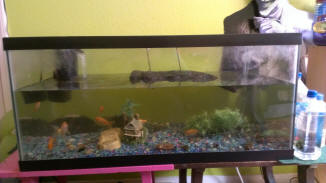 |
re: Hi I want to know if this is shell rot?
Following directions; limit on WWM for file space, incoming
9/12/13
Hi when I was looking at her I noticed those white pieces were loose so
I took them off nothing scrapes off, should I apply hydrogen
peroxide or iodine? I noticed that's what other people do with similar
problems, when you mean they're gonna scar do you mean it's gonna stay
white?
... re-size and re-send your msg. and image file... hundreds of Kbytes,
not Meg.s B
re: Hi I want to know if this is shell rot?
Deleted... re-size...
re: Hi I want to know if this is shell rot?
9/13/13
.... READ here re file size:
http://www.wetwebmedia.com/WWMAdminSubWebIndex/question_page.htm
Item C
|
re: Hi I want to know if this is shell rot?
9/18/13
Sorry about that, ok so I was wondering if I should be applying anything on
it, those little tile looking things were loose and they came right off, and
when you mean its gonna scar what color does it look like after scarring,
ive just been lightly brushing off her back with a children's size tooth
brush I did notice a very tiny red dot barely a needle size
<the red dot is a tiny capillary that is open, so it would be best if you
don't scrub the bare bone. A cotton swab with Hydrogen peroxide is
great - but we want what's there to heal over. Keep her warm and
dry except for her daily bath & feeding (read here about dry-docking
http://www.wetwebmedia.com/FWSubWebIndex/treating%20RES%20Dis%20DarrelB.htm)
and let's see how she's doing in a month. -- Darrel>
|
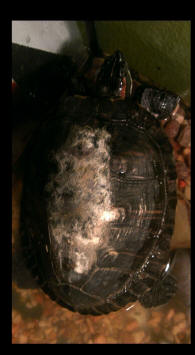
 |
|
|
My Red Ear Slider; Am I worrying too much?
8/16/13
Hi, I'm Keyonna
<Hiya - I'm Darrel>
I've had my Red Ear Slider, Rye, for about a year and a half. He was
very sweet when we got him, but now he's grumpy and mean like an old man.
<So am I. Although in my case I have a pretty good excuse - I *AM* a grumpy
old man!>
The reason I'm writing to you is that, even though I've searched your site
and others, I'm only finding general answers to my questions and those
answers just won't do anymore. So, let me start from the beginning:
<OK - I'm ready!>
When we first got Rye, he was perfectly healthy. My mom had owned turtles
before (4 of them, according to her) so I was counting on her "expertise".
Well, there wasn't any. It really didn't help that Rye was an impulse buy.
So, on top of not knowing what we were doing, we weren't prepared for the
responsibility of a turtle. We didn't get him a filter, a basking light, or
even a basking dock. He had a rock and some water. So, needless to say,
within the first 3 months of having him, his eyes swelled shut. And, what's
worse, I didn't notice until a little over a month had passed. So, we're
already off to a bad start. Fortunately, we did extensive research and found
that Rye had all the signs of being calcium, vitamin A, and vitamin D
deficient. And also fortunately, we found an at home solution that wouldn't
harm Rye, even if it didn't help him. Daily, we gave him a drop of cod liver
oil on each eye and a drop of vitamin A oil in his mouth and we put him in a
small square bowl that had previously belonged to one of my most beloved
pets, my beta fish, Rico (he's in a better place now). I know this is long,
but please, bear with me. Rye (still unable to see) now had a basking lamp
and we fed him mainly oranges; not because we didn't know what his diet
should be, but because that was the only thing he would eat. He had enough
water in there so that he didn't overheat and one day BOOM! He opens his
eyes! (In real time, it was about a week and a half).
<Great to hear>
So, fast forward and I start to notice a few things: Rye's shell is curving
upwards around the edges and the scutes (is that a word?<yep>) sections of
his shell are a bit . . . lumpy. Again, I researched and found that the
curving of the shell could be Metabolic Bone Disease (is that a correct
diagnosis?) and that it often begins early on if they don't have a basking
lamp which, at one time, Rye did not. I read that the disease could be
stopped if I got him a UVB lamp, which I need to buy. He has a heat lamp. I
also read that the lumpiness of Rye's scutes is what's known as pyramiding.
It's not bad . . . well, I guess any kind of pyramiding is bad. But, I can't
reverse it, so I have to work with it.
<I'll get into that a bit later. Please continue>
Another thing is, when I pick him up, he is not at all sociable. If I try to
tickle the back end of his shell, he snaps at me -- and he's caught me twice
already. I've checked his shell over and there are no soft spots, no white
spots, no sort of indication that there might be a fungal or bacterial
infection. Is it at all possible that Rye was simply traumatized by his
first sickness?
<Probably a more simple explanation>
About every 2 weeks, I go over Rye's shell with a soft tooth brush and some
water. Is there a special solution I'm supposed to be using? Do I need to do
this more frequently? Also, if Rye's shell curving p around the edges is
MBD, after I've gotten him a UVB, how will I be able to tell if MBD is
no longer affecting him? I've recently introduced live protein (minnows) and
he loved it. He snubs the leafy greens, though; I've tried everything from
Anacharis to duckweed to romaine lettuce. I'm at a loss. I read somewhere
that younger RESs are more carnivorous than the older ones, but this is just
ridiculous! Is there any way to get him to eat his greens? I put a Marimo
moss ball in his tank, too. I read that it helps keep algae away,
but it seems to have given his water a green tint . . . . Will that go away?
I can't tell if I'm worrying too much or not.
<No - you're worrying exactly the right amount>
Sigh. I love my turtle, but he worries me more than my dogs and rabbit does.
Anyways, thanks so much for reading this! It would be excellent if you'd
reply, though!
<First, you have experienced first hand what it's like to be unprepared and
to make an impulse purchase of a live animal. The problem is that RYE
has also suffered from the pitfalls of an impulse purchase. Still, all
things considered, most people who make impulse purchases don't notice their
errors until it's too late, so really - congratulations on seeing the error
of your ways before Rye became terminal!>
<Now let's start at the beginning. Rye's behavior is not that
unusual for an adult male, which is what you have. He may have been
traumatized by all the past treatments but what's more likely is that as a
little guy he was intimidated by his surroundings so remained quiet.
It's likely that now that he feels grown up and not afraid, he's asserting
himself. Make sure that, when you handle him, you move him slowly,
don't turn him sideways or upside down and that you keep your fingers away
from his head. If you interact with him slowly and calmly, he may
settle down and do the same to you>
<Now the shell. The conditions of the shell don't appear to be primary
MBD as much a signs of an overly fed turtle. It's normal that
the edges of the shell curl a bit as they grow, but the curling and the
pyramiding of the shell can be seen in turtles with bad nutrition and also
TOO MUCH nutrition. Surprisingly I see this all the time.
People who feed their turtles and tortoises a PERFECT diet - but simply feed
them too much and too often - will see the pyramiding of the scutes almost
as if the shell is growing faster than the rest of the animal so the shell
grows inward and upward. The solution is of course, proper
nutrition. For a Red Eared Slider or any water turtle it's either
Repto-Min food sticks or Koi Pellets, which is the same as the Repto-min
only much cheaper, but a COMPLETELY balanced food source. I raise
hatchling sliders that grow into full sized breeders on Kay-Tee brand Koi
Pellets with an occasional (once or twice a month) earthworm as a treat.
Fish, amazingly, are not part of Rye's diet in the wild and aren't all that
good for him -- except that the energy he expends trying to catch them is
good for him.>
<Buy a small bag of Koi pellets, but don't feed Rye for 4 days. He'll
be good and hungry by then. Float a very few pellets in front of him
and give him the opportunity to feed. If he does, great - if not,
scoop out the pellets, skip a day and try again. Trust me, it may be a
test of wills to see which one of you will caved-in first, but he WILL eat
the pellets eventually>
<For his treat, you can also try small pieces of beef or chicken liver.
When I say small I mean no bigger than your pinky finger nail.
Place Rye in a shallow bowl of water (not over his head) give him a few
minutes to settle down and stop trying to climb out, then drop the liver in.
If he's hungry he'll eat it quickly and you can give him a second small
piece.
It's a great source of minerals and vitamins, too.)>
<Rye does need a UV-B lamp. Our friends at Zoo-Med make bulbs that are
a combination of UV-b and heat lamps that fit in a conventional reflector
bulb holder>
<Here is a link to all the stuff you need to know:
http://www.wetwebmedia.com/FWSubWebIndex/RESCareBarton.htm now, if you
read, understand and follow the guidelines in that article, you may never
need THIS article, but scan it anyway
http://www.wetwebmedia.com/FWSubWebIndex/treating%20RES%20Dis%20DarrelB.htm
>
<Now, regarding the pictures, Rye is a handsome looking guy!>
|


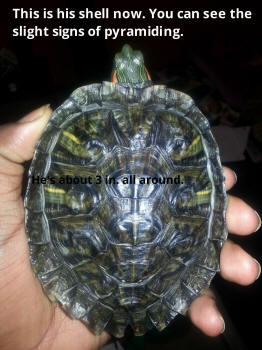

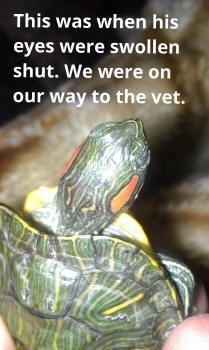
 |
Re: please help this sick turtles Sir
7/17/13
Hello Sir,
<Hiya - Darrel here>
Many many thanks for your precious advices and treatment directions. The
Indian flapshell turtle shell above turned back to new
shell and now only the bottom side rashes remains and those rashes are
also fading and getting disappeared day by day.
<That's what we're here for! Well, that and for the free food!>
I need another help please tell me what to do?
<OK!>
I have got a tank at my roof which is 15 feet long and 3 feet wide and
is 15 centimeters deep, ( I know its less but for now I have no other
option ), the tank have a big 3feet x 3 feet area to hide under for
turtles. It have basking area too an area outside the tank where the
turtles can get out and sit. The whole tank is exposed to sunlight for
4, 5 hours in a daytime depending on sun's direction.
<Yes, the water is a bit shallow but for now my first thought is are
your sure that they turtles can't escape?>
1. in summer the temperature goes as high as 45 degrees Celsius (113f)
in daytime and in night it goes to 30 Celsius (86f) low then also I have
to keep the turtle at roof in same tank?
<The problem, which you already suspect, is that sunlight heats shallow
water faster than deeper water, so sunlight will heat that water quickly
and with evening temps only to 30, the water will never really cool.
POSSIBLY you can help this by covering a good portion of the tank (at
least 50%, maybe 75% with something opaque - so the water that does not
see sunlight will not absorb the heat. This doesn't solve the
problem but if the sunlight is only 4 or 5 hours it may help>
2. in winter the temperature goes low up to 10 degrees Celsius (50f) in
Night and in day it goes up to 32 degrees Celsius (89f) then also I have
to keep the turtle at roof in same tank? (the tank at roof will get
sunlight even in winter season)
<This is not so much of a problem. The daytime temperatures
will allow the shallow water to heat up and 10c (50f) is cold, but for
an overnight that reheats to 10 this is not an issue. Make sure
they can bask during the day -- and watch their feedings. As soon
as the overnight temps drop below 16 degrees reduce their feedings and
when it becomes 10 - discontinue completely until the weather warms.
Non-digested food in their gut is the only problem I'd worry about>
Many thanks
|
Shell Rot? 6/15/13
Hi crew,
<Hiya - Darrel here>
My 7 1/2 year old red eared slider turtle, Speed, who has recently
developed this white mark on his shell. I have attached a picture of it.
<That tiny little white spot?>
The day after I took this photo his shell appeared to be in rough shape,
with it peeling in various layers. (I have also attached a photo of this
but when his shell is dry) So I am wondering is this shell rot?
<Nope - I don't think so>
I have been dry-docking him for two days now and each day treated him with
betadine (povidone-iodine) and even after just treating him twice I am
seeing improvement. So, am I treating shell rot? If so, what other
measures should I take to help him?
<Emma - the description you give is almost the natural shedding of the
scutes as new ones grow underneath. That natural, almost
"scratched" look is not all that uncommon.>
<The deciding factor here is this: Shell Rot isn’t a disease, it's
the RESULT of a fungal infection. If it is fungus it will be soft
and you'll be able to scrape a small layer of it off the shell and it
will smell bad and foul. If the pieces coming off are hard
(like thin layers of fingernail) then they are normal and nothing to
worry about>
Thank you so much!
From, Emma
|
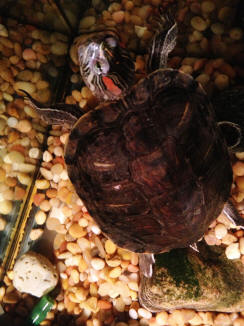
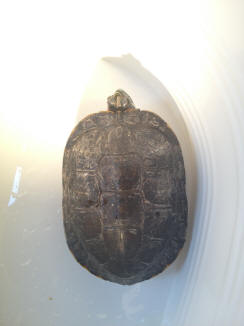 |
Spot on my Res 5/7/13
Hi guys!
<Hiya Lauryn!! Darrel here>
I just recently purchased a Red Eared Slider who is about an inch and a
half in length. I've noticed his shell is a little soft so he is
definitely gonna get more sunlight from now on!!
<UV-B lighting is required>
His tank is a 40 gallon with a filter and a heat lamp and dock.
<Read here, Lauryn. It's all you need to know about giving little
Nirkus a good home:
http://www.wetwebmedia.com/FWSubWebIndex/RESCareBarton.htm >
Though I noticed a strange dot on him. Can you tell me what this is?
<Yep - that little numb is what's left of his umbilicus -- that is the
dried remains of what was once an egg sac that hung underneath and fed
him all the time he was in the egg. If will dry up and either fall
of or wear off as he gets older. No worries>
Thank you so very much!
Lauryn
|
shell concerns, general care... no searching, reading on
WWM... too large image files... 4/8/13
hello there,
<Hi Michelle; Sue here with you.>
I just got this turtle and I wanted to know if his shell is in proper
condition. How can I make his shell better? What are the
green spots?
<It looks like algae from here. With indoor turtles, this can
happen when food/waste/organic material accumulates in the water. You
can try taking a soft toothbrush, gently rub it over the shell, and see
if it comes off.>
What are the white shots?
<Shell discolorations like this can be the result of a number of things:
bacterial or fungal infection, shell rot, scarring from previous shell
issues, or something as simple as mineral deposits from water.>
Does he look healthy and how can I bring him back to health?
<It’s hard to say from just a photo alone. Is his shell soft or
hard? Is there any odor to it? Given what you’re saying below
about the kind of conditions he lived in before you got him, I’d suggest
taking him to a vet who can physically examine it (see more about this
at the end of my note).>
<In terms of evaluating his overall health besides just his physical
appearance you also want to consider how he’s behaving, i.e. – Does he
have a good appetite? Is he alert and active, or lethargic and just
sitting in the water? Does he get out of the water and bask for
several hours a day? These are also very telling indicators for how he’s
feeling.>
He is an adult male red eared slider. The previous owners were not
caring for him properly. He was in a holding tank, no lights, no
basking area, no heater. Now that I have him, I got a 60 gallon
tank, the proper lighting, heating, etc.
<That was great of you to do that for him; thanks for taking him under
your wing! It sounds like you’ve done a lot of research in finding
out about his needs. It all sounds good so far. One question on the
lighting, though, what do you mean by proper lighting? Do you have
both a UVB light and heat light? Both are important and necessary.>
<Also you didn’t mention water and basking temperatures; whether you
have a filter (or if so how strong it is); what kind of water changes
you’re doing; what/how much/how often you’re feeding him, etc. These are
also very important aspects of care.>
He seems very happy but I just wanted to know the condition of his shell
and how I can improve it.
<Well first, I’ll give you a link to our care guide just to make sure
you have all the basics (such as some of the ones I mentioned above)
covered:
http://www.wetwebmedia.com/FWSubWebIndex/RESCareBarton.htm >
<The next thing because of his history, I’d also recommend you take him
to the vet for a check-up, preferably one who has some experience with
turtles. There’s no substitute for a 1st hand physical examination; in
particular a stool test and basic blood test to rule out infection. You
may also want to ask if they can take a sample of some of the material
on his shell and look at it under a microscope to see if there’s any
sort of surface bacterial infection going on. If it turns out there is,
the vet can prescribe a topical antibiotic such as Silvadene cream.>
<Lastly, because of his shell appearance and little to no
basking/UVB/heat lamp exposure up to this point, I’d dry dock him for at
least a couple of weeks. If he does have some sort of shell fungus, the
warm dry environment (with UVB) will help clear it up. And even if he
doesn’t, dry docking will give his immune system a little boost.
This link has instructions for how to do that (see under “Isolation and
Dry Dock”). Just make sure to give him access to water for a short time
each day to drink, poop, etc. –
http://www.wetwebmedia.com/FWSubWebIndex/treating%20RES%20Dis%20DarrelB.htm
Thank you, Michelle
<You’re welcome; good luck with him! If you take him to the vet,
let us know how it goes; and if you still have any questions after
reading through all this, feel free to write us back! ~ Sue >
|
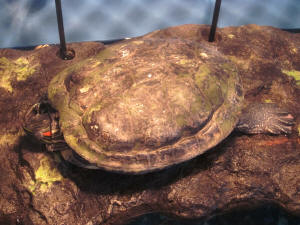
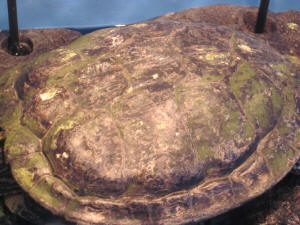
|
Re: shell concerns, general care
4/12/13
Hi there, thank you for your reply.
<You’re welcome!>
Just to answer your questions. He is a 30 year old male red eared
slider. His shell is hard and the white spots are hard as well.
There is no odor.
<More than likely then it’s either mineral deposits that have built up
from water or scarring from past problems. I’d keep an eye on it though
and if you think it’s getting worse, it might be worth a trip to the vet
to see if they can examine some of the material under a microscope just
to rule out any sort of bacterial infection.>
The green on his shell did come off when I brushed him with a tooth
brush, thank you.
<Glad to hear that helped.>
I do have a heat light and he does bask all day. I turn the light
on in the morning and turn it off at night. The second I turn on
the light he basks all day for about 12 hours. When I turn off the
light, he goes back in the water under the UVB light.
<The UVB light should also be over his basking area along with heat
lamp. I wouldn’t keep it over the water because that will encourage
algae growth.>
I feed him every night and he gets the turtle pellets because that is
what the previous owner always fed him.
<Would cut this feeding back to only 2-3 times a week. Overfeeding is
the most common mistake people make and it can contribute to shell
deformities. From looking at the photos of him there appeared to
me to be a little bit of shell pyramiding.>
<Also when you do feed him pellets, feed him only as much as he can eat
in 5 minutes or so, no more.>
I have also been giving him Kale and Dandelion leaves. He has been
eating the leaves and seems to really like it.
<That’s good, and dandelion greens in particular are very nutritious.
You can give him unlimited quantities of dandelion greens but I’d go a
little more moderate on the kale; just once in a while.>
Question: do I leave the UVB light on all night since this is the only
time he goes in the water?
<No, as above, you want the UVB (and heat lamp) both directly over him
on his basking area. Then turn both off at night.>
Also, his behaviour,....he has a great appetite, he eats every night,
<If you can, better to feed him in the morning. The basking under the
lights is what helps him properly digest the food.>
I am slowly trying to change his diet to real healthy food like kale,
lettuce, dandelion, crickets etc. but I don't want him to go into shock
with all the different changes recently.
<Skip the crickets altogether and replace with 1-2 earthworms every few
weeks. Much better for him. Feed the kale and dandelion greens as
above. For lettuce, stay away from iceberg lettuce (no nutrient value at
all). Red leaf lettuce, curly green leaf lettuce and leafy greens
are better.>
Also, since he has been basking for 12 to 13 hours a day his shell has
been peeling and the new shell underneath has no white spots or in some
places the white shots are much smaller.
<That’s great. When they shed, healthy new shell growth underneath is
what you want to see.>
Also, he is not lethargic, he is alert and active in the water at night.
<All very good signs!>
Also regarding the water temperatures I have the water heater set at 78
but I'm not sure if that is too hot because for 30 years he has had no
heater at all and I don't want him to go into shock.
<No, actually you don’t want a water heater at all. Because turtles are
dependent on their environment to regulate their body temperature, you
want to give them the choice between cool (68-70 - room temperature is
fine) water, and warm dry land. Also, warmer water also encourages algae
growth.>
I do have a filter and it is the Tetra filter and it seems to be doing a
great job. I also have been taking all the water out once a week
and cleaning his tank and refilling it with new water.
<Sounds good. You may also want to consider feeding him outside of his
tank in a plastic storage bin if you have one. Just put a couple of
inches of water in it. Until he gets used to it, it may take him a few
minutes to calm down after you put him in it so wait until he does calm
down before feeding him. Then just let him eat for about 5 minutes,
maybe give him a few more minutes to see if he poops, then put him back
in the tank. That will help his water stay cleaner throughout the week.
And if you do see any waste during the week, make sure to scoop it out
as you don’t want it decomposing in the water, even with a filter.>
He has a mineral rock in the water as well. Thank you for taking the
time to read this. Your advice has been helpful.
<Glad to hear that! From everything you’ve said, it sounds like
you’re doing a great job and he appears to be doing better as well. Just
make the few tweaks above that I mentioned and that should help! ~ Sue >
Michelle
Re: shell concerns, general care 4/12/13
Hi There,
<Hi again!>
I just wanted to send you pictures of the difference in the turtles
shell. The first picture is how the turtle’s shell looks now,
exactly 9 days after I took him under my care. All the algae is
now gone. I used a toothbrush and gently cleaned most of it off.
Also the white spots on his shell are getting smaller and in some places
that he has shed the white spots are gone completely. The second
picture is a picture of his shell the day I got him. It looks like
the basking all day and the UVB light are improving his overall
appearance. What do you think?
<His shell does seem to be looking much better, Michelle! You’re
being a good turtle mom! And I’ll bet he’s really appreciating finally
getting to be his “turtle self” and basking after all these years!!
And yes, for certain the heat and UVB is the best thing for his shell.
Just make sure they’re placed as I mentioned in my last note, both
directly over his basking area.>
<And as I said, just keep an eye on his shell and if you have any
concerns, take him to a vet and ask if they can examine some of the
material under a microscope to rule out any sort of bacterial infection.
I hope he continues to improve for you! Any other concerns though, feel
free to write us. ~ Sue>
|

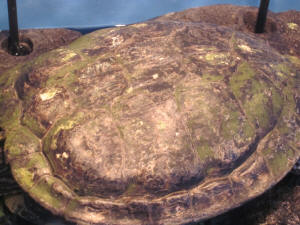 |
|
|
|

